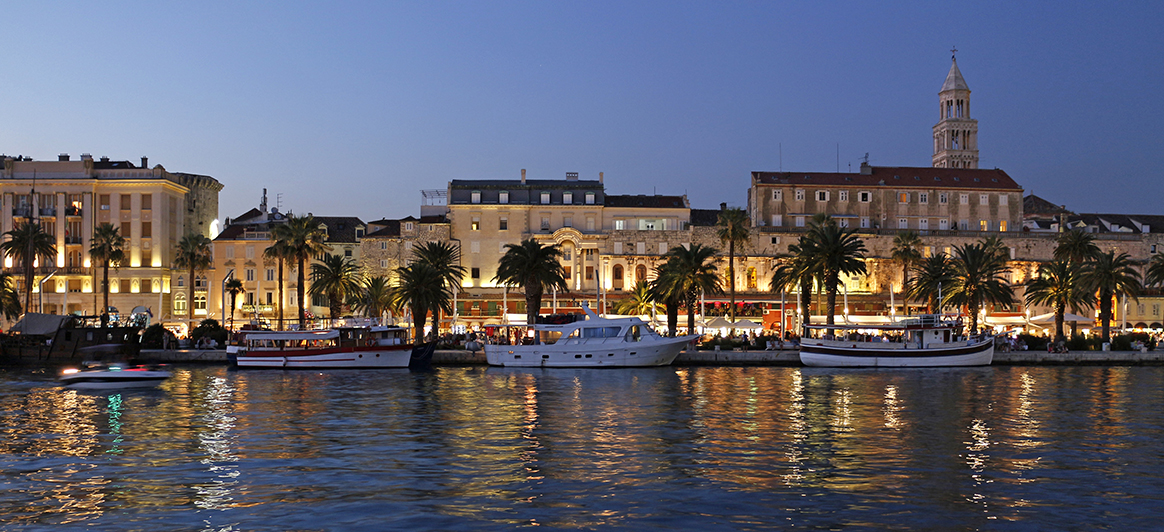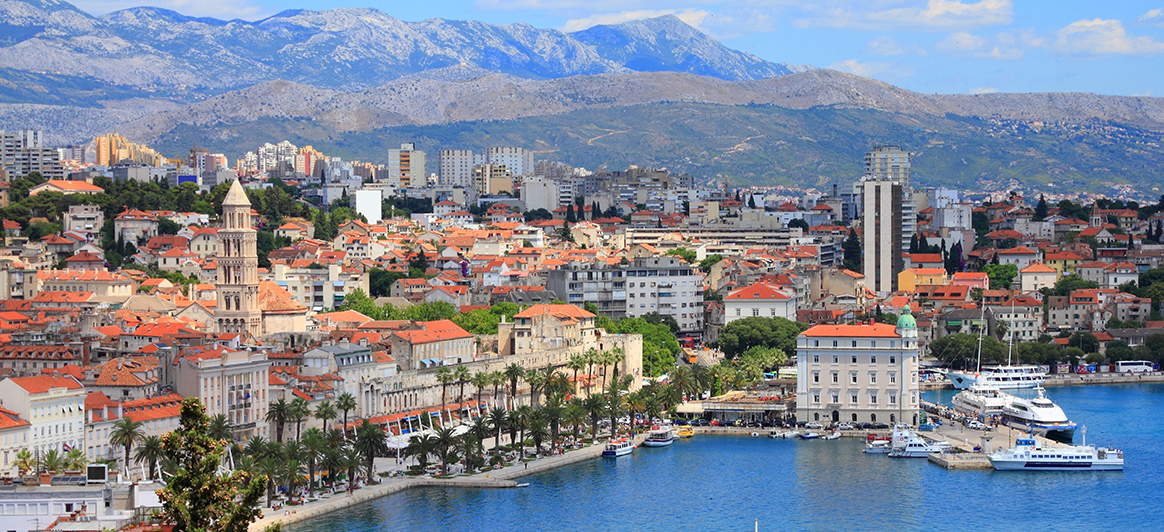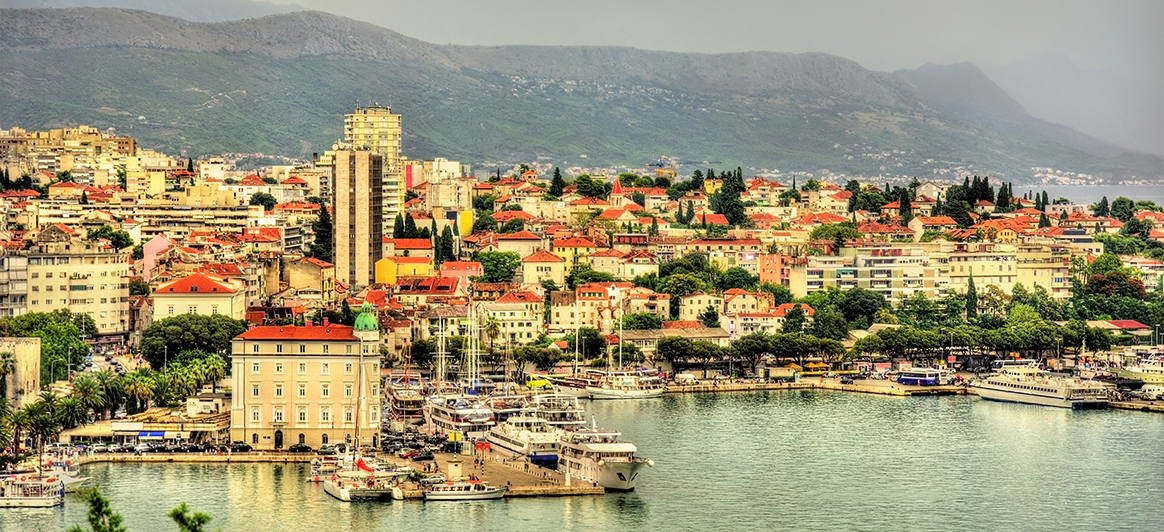
Book a Flight to Split from €53
To book tickets for children traveling alone click here

Find the lowest fares to Split
Athens (ATH)to
Split (SPU)*Fares displayed have been collected within the last 48hrs and may no longer be available at time of booking. Additional fees and charges for optional products and services may apply.
AEGEAN popular flights to Split
From | To | Fare Type | Dates | Price |
|---|---|---|---|---|
| Athens (ATH) | Split (SPU) | One-way fare / Economy | Departing: 19/07/2026 | Starting from €53* Seen: 20 hours ago |
| Athens (ATH) | Split (SPU) | One-way fare / Economy | Departing: 05/08/2026 | Starting from €66* Seen: 20 hours ago |
| Athens (ATH) | Split (SPU) | One-way fare / Economy | Departing: 09/08/2026 | Starting from €66* Seen: 20 hours ago |
| Athens (ATH) | Split (SPU) | One-way fare / Economy | Departing: 22/07/2026 | Starting from €66* Seen: 19 hours ago |
| Athens (ATH) | Split (SPU) | One-way fare / Economy | Departing: 12/08/2026 | Starting from €66* Seen: 20 hours ago |
| Athens (ATH) | Split (SPU) | One-way fare / Economy | Departing: 19/08/2026 | Starting from €66* Seen: 20 hours ago |
| Athens (ATH) | Split (SPU) | One-way fare / Economy | Departing: 12/07/2026 | Starting from €66* Seen: 20 hours ago |
| Athens (ATH) | Split (SPU) | One-way fare / Economy | Departing: 16/08/2026 | Starting from €66* Seen: 14 hours ago |
| Athens (ATH) | Split (SPU) | One-way fare / Economy | Departing: 09/09/2026 | Starting from €66* Seen: 18 hours ago |
| Athens (ATH) | Split (SPU) | One-way fare / Economy | Departing: 28/09/2026 | Starting from €66* Seen: 50 minutes ago |
*Fares displayed have been collected within the last 48hrs and may no longer be available at time of booking. Additional fees and charges for optional products and services may apply.

Plan your Trip to Split
Spread out over a unique natural landscape, with the coastal mountains of Croatia in the background and a view over the Adriatic, Split is the heart of Dalmatia, a historic port city with a Mediterranean character and a cosmopolitan air. Wander through the atmospheric cobbled lanes of the Old City, take a stroll in the moonlight in the grand Diocletian’s Palace, tour the picturesque medieval quarters of Veli Varoš and Manuš. Admire the wonderful scenery of Split from the peak of the green Marjan hill and seek out the sites where Game of Thrones is filmed. If the magical fairy tale that Split offers is not enough for you, jump on a ferryboat and set sail for the dreamlike islands of Hvar and Brac on the Dalmatian costiera with the emerald beaches, Renaissance palaces, and endless sunset cocktails.
Book your tickets for Split with Aegean Airlines and get to know one of the most charming cities in Europe from up close.
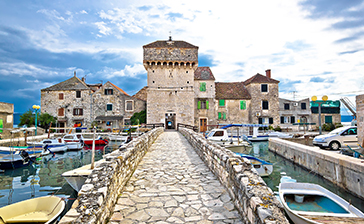
Diocletian’s Palace: The idea of the emperor Diocletian in 305 to build a palace in Split for the days when he would withdraw from public life gave the city one of the most imposing Roman monuments in the world (UNESCO World Heritage site). The grand palace structure, surrounded by tall walls with three entrance gates, is an impressive complex of roads, temples, imperial apartments and a peristyle court. In its approximately 220 buildings, beats the heart of the city’s historic centre, with a plethora of houses, shops, cafes and restaurants. Address: Dioklecijanova 5, Split
Cathedral of Saint Domnius: Dedicated to the city’s patron saint, St Duje, the symbolic church of Split is the centre of an impressive ecclesiastical complex. Its construction commenced in 305 as the mausoleum of Diocletian and was later converted into a Christian church, with many additions over the centuries. The oldest monuments in the church include the amazing wood-carved compositions (13th century) in the central entrance, made by Andrija Buvina. The top of the bell tower offers the best view over the whole city, the green Marjan hill and the nearby islands of the Dalmatian coasts. Address: Svetog Duje 5, 21000 Split
Ivan Meštrović Gallery: This impressive neoclassical villa is home to the best art museum in Split. Built by the most important Croatian sculptor of the 20th century, Ivan Meštrović, to serve as his private residence, the villa houses an excellent collection of his work today. Combine your visit here with a trip to nearby Kastelet, the 16th-century summer residence that Meštrović bought and renovated in order to house his wonderful collection of wooden sculptures. Address: Šetalište Ivana Meštrovica 46, Split, www.mestrovic.hr
Archaeological Museum: The oldest museum in Croatia (1820) and one of the most important museums of Roman antiquities in Europe and beyond. Admire the wonderful collection of thousands of stone epitaphs from the region of Salona, as well as hundreds of Roman, Greek and Illyrian artefacts (pottery, jewellery, coins). Address: Zrinsko-Frankopanska 25, 21000 Split
Croatian Maritime Museum: Climb up to the baroque 17th-century Venetian fortress of Gripe to explore Split’s great maritime heritage through the fantastic collection of the Maritime Museum. Here you can admire model ships, rare finds from ancient shipwrecks, diving and fishing equipment, anchors and much more. The highlight of the Museum is its unique collection of torpedoes, a Croatian invention.Address: Glagoljaška 18, 21000 Split, www.hpms.hr
City Museum: An exceptional example of 15th-century Late Gothic architecture, the Papalić Palace was built to house the noble Papalić family of Split. Its renovated interior today houses the City Museum. Here the visitor will be taken on a wonderful journey through the historical and cultural legacy of Split, through various works of art, photographs, manuscripts, knightly coats-of-arms, and weapons from the 17th century. Address: Papalićeva 1, Split, www.mgst.net
Split Museum of Fine Arts: The history of the Split Museum of Fine Arts starts in 1931 and its valuable collection numbers over 5,200 works of art from the 14th century until today. Here you can admire the great masters of Italian painting (14th-18th century) and other painters, amazing Byzantine icons, as well as a unique panorama of modern and contemporary Croatian art, and works by the famous painter Vlaho Bukovac. Address: Ulica kralja Tomislava 15, 21000 Split, www.galum.hr
Veli Varoš: Stroll through the narrow cobbled lanes of the picturesque medieval district of Veli Varoš, with the traditional stone houses built by villagers and fishermen in the 17th century. This beautiful district is located on the southernmost slope of the green Marjan hill, a forested oasis with charming footpaths for walks, numerous medieval chapels and rocky beaches. Climb up to the top of the hill to enjoy an unrivalled view over the surrounding islands and incoming ferries.
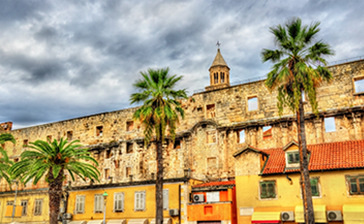
The central market of Split offers a very pleasant shopping experience, since the best department stores, antique shops, art galleries and souvenir shops are gathered here, in the atmospheric little streets surrounded by the walls of Diocletian’s Palace. In the underground apartments of the imperial palace complex itself you will find many small shops and stalls with souvenirs from Split and the surrounding region of the Adriatic. Here you can buy paintings, handmade lace, jewellery and even copies of Roman busts.
For designer clothes and accessories, go to the marble paved Marmontova Street, where famous fashion houses and international retail chains can be found. If you want to combine shopping with a complete recreational experience, choose City Centre One. The city’s largest shopping mall has a Cineplex and restaurants, and even a go-kart arena.
The foodies of the gang will be delighted by the colours and aromas of the Stari Pazar, the daily outdoor food and flower market of Split. In addition to the fresh, top-quality produce, many cheap gadgets and souvenirs can also be found on offer at the stalls. Along with the famous Ribarnica fish market, this is the most popular foodie walking route in Split.
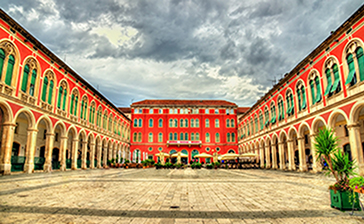
The gastronomic identity of Split is typically Mediterranean, based on the exceptionally high quality of the local produce. Start your day with a marenda (a full brunch) and don’t miss the chance to visit a traditional konoba (underground tavern or wine cellar with wooden tables and a characteristic rustic atmosphere) to taste the flavours of Dalmatia. Try the traditional pašticada (casserole with beef marinated in wine and plums) with potato gnocchi, peka (oven-baked dish with vegetables, potatoes and meat or seafood), the famous pršut (Dalmatian prosciutto), paški sir (cheese from the island of Pag), and, of course, the exceptionally fresh grilled seafood, always accompanied by the famous blitva (chard and potatoes). Top your meal off with paradizet (Dalmatian tiramisu) or rosata (a kind of crème brulee with rose liqueur).
For lovers of street food, all roads lead to the open-air barbecues that are set up daily outside the fish market. Try the sardines or squid on a skewer, served on fresh bread with a little olive oil and salt, the locals’ favourite afternoon snack.
Split is famed for its intense nightlife. Follow the young Splicani to the best-known places for fun in the city, from the cafes of the coastal pedestrian road of Riva, to the bars and pubs of the Old City around the Peristyle and Narodni Square (Pjaca), or the gay-friendly Ghetto club. In the summer, the partying starts at the nightclubs that are spread out around the little harbour of Matejuška and continues in the discoes of the famous Bačvice beach, until the morning hours.

- Split Summer Festival: The largest arts festival of Split is held each summer (15 July-15 August). All those visiting Dalmatia in this period will enjoy top-notch theatre, dance, classical music and opera in some of the most beautiful open spaces of the city, such as the Peristyle and the squares of the Old City.
- Split Film Festival: Come to Split in mid-September for a seven-day festival of cinematic pleasure, with an emphasis on independent and subversive art house movies from all over the world.
- Ultra Europe: The crème de la crème of the world’s electronic and dance music meets in Split for a three-day party (15-17 July 2016) to the sounds of the best DJs on the planet. Over 150 sets, four stages, an amazing light show, fireworks and 70,000 enthusiastic fans transform the arena of the Poljud Stadium into a phantasmagorical party with no tomorrow. The famous stars on the decks include a line-up with Armin van Buuren, Carl Cox and Afrojack, while many satellite parties are held on the neighbouring small islands of Hvar and Brac.
- Days of Diocletian: If you are a fan of folklore with strong doses of theatricality and on-stage extravaganzas, you will love the “reappearance” of the Emperor Diocletian in the city and the revival of Split’s Roman days. For four days every August, the roads of the palace are filled with people dressed in togas and tunics, while Roman carriages trundle along the paved Riva promenade, and gastronomic symposia are held among the open-air stalls of the Old City. Parades with Roman legions and gladiatorial battles in the arena with wooden swords are also anticipated. The highlight of the programme is the arrival of the emperor and his escort at the Peristyle, where he will give a speech to the people of the city.
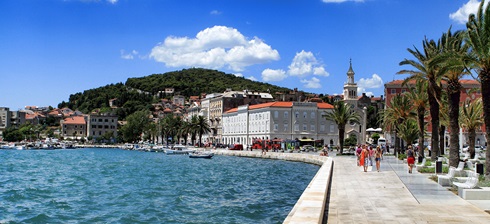
Getting from the airport to the city
Aegean Airlines lands at Split Airport, 20 km southwest of Split, near the town of Kaštela. Here you will find Travel Value and Duty Free shops, a mini market with authentic Croatian souvenirs, gifts, newspapers and tobacco products, a bank and foreign exchange bureau, restaurants and bars. Wi-Fi is free in all areas of the airport. The fastest and cheapest way to reach the city centre is to take the Pleso shuttle bus, which has a direct connection from the airport to the Central Bus Station (platform 1) of Split, near the port. Buses depart daily from 7.10 to 22.15, 20 minutes after the arrival of each flight. The journey takes 30 minutes.

Diocletian’s Palace: The idea of the emperor Diocletian in 305 to build a palace in Split for the days when he would withdraw from public life gave the city one of the most imposing Roman monuments in the world (UNESCO World Heritage site). The grand palace structure, surrounded by tall walls with three entrance gates, is an impressive complex of roads, temples, imperial apartments and a peristyle court. In its approximately 220 buildings, beats the heart of the city’s historic centre, with a plethora of houses, shops, cafes and restaurants. Address: Dioklecijanova 5, Split
Cathedral of Saint Domnius: Dedicated to the city’s patron saint, St Duje, the symbolic church of Split is the centre of an impressive ecclesiastical complex. Its construction commenced in 305 as the mausoleum of Diocletian and was later converted into a Christian church, with many additions over the centuries. The oldest monuments in the church include the amazing wood-carved compositions (13th century) in the central entrance, made by Andrija Buvina. The top of the bell tower offers the best view over the whole city, the green Marjan hill and the nearby islands of the Dalmatian coasts. Address: Svetog Duje 5, 21000 Split
Ivan Meštrović Gallery: This impressive neoclassical villa is home to the best art museum in Split. Built by the most important Croatian sculptor of the 20th century, Ivan Meštrović, to serve as his private residence, the villa houses an excellent collection of his work today. Combine your visit here with a trip to nearby Kastelet, the 16th-century summer residence that Meštrović bought and renovated in order to house his wonderful collection of wooden sculptures. Address: Šetalište Ivana Meštrovica 46, Split, www.mestrovic.hr
Archaeological Museum: The oldest museum in Croatia (1820) and one of the most important museums of Roman antiquities in Europe and beyond. Admire the wonderful collection of thousands of stone epitaphs from the region of Salona, as well as hundreds of Roman, Greek and Illyrian artefacts (pottery, jewellery, coins). Address: Zrinsko-Frankopanska 25, 21000 Split
Croatian Maritime Museum: Climb up to the baroque 17th-century Venetian fortress of Gripe to explore Split’s great maritime heritage through the fantastic collection of the Maritime Museum. Here you can admire model ships, rare finds from ancient shipwrecks, diving and fishing equipment, anchors and much more. The highlight of the Museum is its unique collection of torpedoes, a Croatian invention.Address: Glagoljaška 18, 21000 Split, www.hpms.hr
City Museum: An exceptional example of 15th-century Late Gothic architecture, the Papalić Palace was built to house the noble Papalić family of Split. Its renovated interior today houses the City Museum. Here the visitor will be taken on a wonderful journey through the historical and cultural legacy of Split, through various works of art, photographs, manuscripts, knightly coats-of-arms, and weapons from the 17th century. Address: Papalićeva 1, Split, www.mgst.net
Split Museum of Fine Arts: The history of the Split Museum of Fine Arts starts in 1931 and its valuable collection numbers over 5,200 works of art from the 14th century until today. Here you can admire the great masters of Italian painting (14th-18th century) and other painters, amazing Byzantine icons, as well as a unique panorama of modern and contemporary Croatian art, and works by the famous painter Vlaho Bukovac. Address: Ulica kralja Tomislava 15, 21000 Split, www.galum.hr
Veli Varoš: Stroll through the narrow cobbled lanes of the picturesque medieval district of Veli Varoš, with the traditional stone houses built by villagers and fishermen in the 17th century. This beautiful district is located on the southernmost slope of the green Marjan hill, a forested oasis with charming footpaths for walks, numerous medieval chapels and rocky beaches. Climb up to the top of the hill to enjoy an unrivalled view over the surrounding islands and incoming ferries.

The central market of Split offers a very pleasant shopping experience, since the best department stores, antique shops, art galleries and souvenir shops are gathered here, in the atmospheric little streets surrounded by the walls of Diocletian’s Palace. In the underground apartments of the imperial palace complex itself you will find many small shops and stalls with souvenirs from Split and the surrounding region of the Adriatic. Here you can buy paintings, handmade lace, jewellery and even copies of Roman busts.
For designer clothes and accessories, go to the marble paved Marmontova Street, where famous fashion houses and international retail chains can be found. If you want to combine shopping with a complete recreational experience, choose City Centre One. The city’s largest shopping mall has a Cineplex and restaurants, and even a go-kart arena.
The foodies of the gang will be delighted by the colours and aromas of the Stari Pazar, the daily outdoor food and flower market of Split. In addition to the fresh, top-quality produce, many cheap gadgets and souvenirs can also be found on offer at the stalls. Along with the famous Ribarnica fish market, this is the most popular foodie walking route in Split.

The gastronomic identity of Split is typically Mediterranean, based on the exceptionally high quality of the local produce. Start your day with a marenda (a full brunch) and don’t miss the chance to visit a traditional konoba (underground tavern or wine cellar with wooden tables and a characteristic rustic atmosphere) to taste the flavours of Dalmatia. Try the traditional pašticada (casserole with beef marinated in wine and plums) with potato gnocchi, peka (oven-baked dish with vegetables, potatoes and meat or seafood), the famous pršut (Dalmatian prosciutto), paški sir (cheese from the island of Pag), and, of course, the exceptionally fresh grilled seafood, always accompanied by the famous blitva (chard and potatoes). Top your meal off with paradizet (Dalmatian tiramisu) or rosata (a kind of crème brulee with rose liqueur).
For lovers of street food, all roads lead to the open-air barbecues that are set up daily outside the fish market. Try the sardines or squid on a skewer, served on fresh bread with a little olive oil and salt, the locals’ favourite afternoon snack.
Split is famed for its intense nightlife. Follow the young Splicani to the best-known places for fun in the city, from the cafes of the coastal pedestrian road of Riva, to the bars and pubs of the Old City around the Peristyle and Narodni Square (Pjaca), or the gay-friendly Ghetto club. In the summer, the partying starts at the nightclubs that are spread out around the little harbour of Matejuška and continues in the discoes of the famous Bačvice beach, until the morning hours.

- Split Summer Festival: The largest arts festival of Split is held each summer (15 July-15 August). All those visiting Dalmatia in this period will enjoy top-notch theatre, dance, classical music and opera in some of the most beautiful open spaces of the city, such as the Peristyle and the squares of the Old City.
- Split Film Festival: Come to Split in mid-September for a seven-day festival of cinematic pleasure, with an emphasis on independent and subversive art house movies from all over the world.
- Ultra Europe: The crème de la crème of the world’s electronic and dance music meets in Split for a three-day party (15-17 July 2016) to the sounds of the best DJs on the planet. Over 150 sets, four stages, an amazing light show, fireworks and 70,000 enthusiastic fans transform the arena of the Poljud Stadium into a phantasmagorical party with no tomorrow. The famous stars on the decks include a line-up with Armin van Buuren, Carl Cox and Afrojack, while many satellite parties are held on the neighbouring small islands of Hvar and Brac.
- Days of Diocletian: If you are a fan of folklore with strong doses of theatricality and on-stage extravaganzas, you will love the “reappearance” of the Emperor Diocletian in the city and the revival of Split’s Roman days. For four days every August, the roads of the palace are filled with people dressed in togas and tunics, while Roman carriages trundle along the paved Riva promenade, and gastronomic symposia are held among the open-air stalls of the Old City. Parades with Roman legions and gladiatorial battles in the arena with wooden swords are also anticipated. The highlight of the programme is the arrival of the emperor and his escort at the Peristyle, where he will give a speech to the people of the city.

Getting from the airport to the city
Aegean Airlines lands at Split Airport, 20 km southwest of Split, near the town of Kaštela. Here you will find Travel Value and Duty Free shops, a mini market with authentic Croatian souvenirs, gifts, newspapers and tobacco products, a bank and foreign exchange bureau, restaurants and bars. Wi-Fi is free in all areas of the airport. The fastest and cheapest way to reach the city centre is to take the Pleso shuttle bus, which has a direct connection from the airport to the Central Bus Station (platform 1) of Split, near the port. Buses depart daily from 7.10 to 22.15, 20 minutes after the arrival of each flight. The journey takes 30 minutes.

